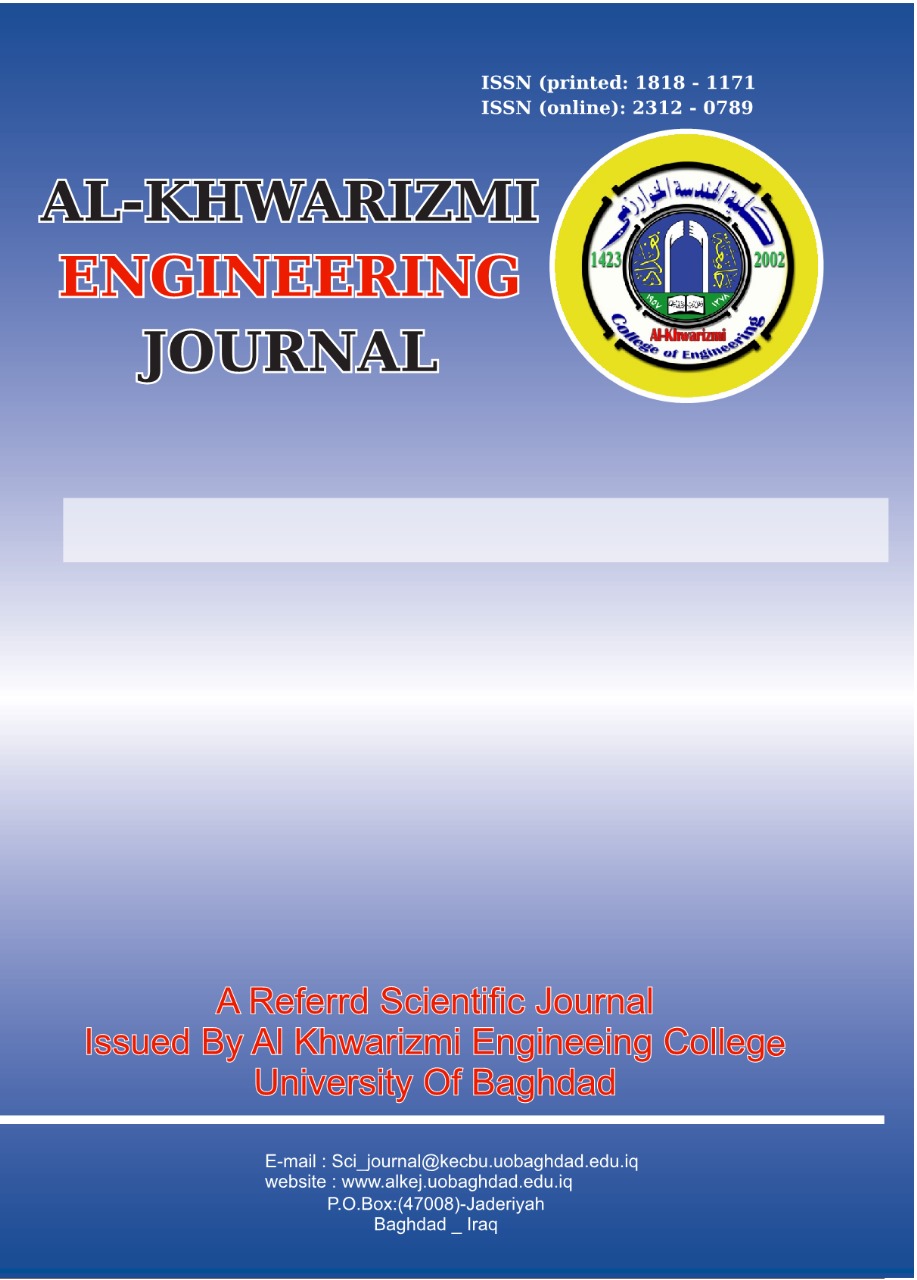إزالة الميثيلين الازرق من مياه الصرف الصحي بواسطة نبات الحاجي كمادة مازة منخفضة التكلفة وصديقة للبيئة
DOI:
https://doi.org/10.22153/kej.2025.02.002الكلمات المفتاحية:
Al Haji plant; Batch sorption; Kinetic models; Methylene blue; Thermodynamic Parameter.الملخص
التنزيلات
المراجع
Zhang, T., et al., Removal of heavy metals and dyes by clay-based adsorbents: From natural clays to 1D and 2D nano-composites. Chemical Engineering Journal, 2021. 420: p. 127574.
Lellis, B., et al., Effects of textile dyes on health and the environment and bioremediation potential of living organisms. Biotechnology Research and Innovation, 2019. 3(2): p. 275-290.
Karim, A.B., et al., Élimination du colorant basique «Bleu de Méthylène» en solution aqueuse par l’argile de Safi. Revue des sciences de l'eau, 2010. 23(4): p. 375-388.
Obed, A.S. and W.M. Sheet, Removal of Azo Dye (Dispersed Red 17) Using Activated Carbon and Studying the Influencing and Kinetic Factors. Mathematical Statistician and Engineering Applications, 2023. 72(1): p. 2246–2256-2246–2256.
Hamad, H., et al., A novel modification and selective route for the adsorption of Pb2+ by oak charcoal functionalized with glutaraldehyde. Advanced Powder Technology, 2016. 27(2): p. 631-637.
Yurtsever, M. and İ.A. Şengil, Biosorption of Pb (II) ions by modified quebracho tannin resin. Journal of Hazardous Materials, 2009. 163(1): p. 58-64.
Hamidpour, M., et al., Sorption hysteresis of Cd (II) and Pb (II) on natural zeolite and bentonite. Journal of hazardous materials, 2010. 181(1-3): p. 686-691.
Yang, L., et al., Development of eco-friendly CO2-responsive cellulose nanofibril aerogels as “green” adsorbents for anionic dyes removal. Journal of Hazardous Materials, 2021. 405: p. 124194.
Saleh, T.A. and V.K. Gupta, Photo-catalyzed degradation of hazardous dye methyl orange by use of a composite catalyst consisting of multi-walled carbon nanotubes and titanium dioxide. Journal of colloid and interface science, 2012. 371(1): p. 101-106.
Gupta, V.K., et al., Removal of the hazardous dye—Tartrazine by photodegradation on titanium dioxide surface. Materials science and engineering: C, 2011. 31(5): p. 1062-1067.
Nassar, N.N., Rapid removal and recovery of Pb (II) from wastewater by magnetic nanoadsorbents. Journal of hazardous materials, 2010. 184(1-3): p. 538-546.
Shooto, N.D., P.M. Thabede, and E.B. Naidoo, Simultaneous adsorptive study of toxic metal ions in quaternary system from aqueous solution using low cost black cumin seeds (Nigella sativa) adsorbents. South African Journal of Chemical Engineering, 2019. 30: p. 15-27.
Khan, N.A., S. Ibrahim, and P. Subramaniam, Elimination of heavy metals from wastewater using agricultural wastes as adsorbents. Malaysian journal of science, 2004. 23(1): p. 43-51.
Peng, L., et al., Molecular characterization of H9N2 influenza virus isolated from mink and its pathogenesis in mink. Veterinary Microbiology, 2015. 176(1-2): p. 88-96.
Dimbo, D., et al., Methylene blue adsorption from aqueous solution using activated carbon of spathodea campanulata. Results in Engineering, 2024: p. 101910.
Salman, S.D., I.M. Rasheed, and A.K. Mohammed. Adsorption of heavy metal ions using activated carbon derived from Eichhornia (water hyacinth). in IOP Conference Series: Earth and Environmental Science. 2021. IOP Publishing.
Jagtoyen, M. and F. Derbyshire, Activated carbons from yellow poplar and white oak by H3PO4 activation. Carbon, 1998. 36(7-8): p. 1085-1097.
Ting, Y., F. Lawson, and I. Prince, Uptake of cadmium and zinc by the alga Chlorella vulgaris: Part 1. Individual ion species. Biotechnology and Bioengineering, 1989. 34(7): p. 990-999.
Albroomi, H., et al. Removal Of A Basic And Azo Dye From Aqueous Solution By Adsorption Using Activated Carbon. in The International Conference on Chemical and Environmental Engineering. 2014. Military Technical College.
Annadurai, G., R.-S. Juang, and D.-J. Lee, Use of cellulose-based wastes for adsorption of dyes from aqueous solutions. Journal of hazardous materials, 2002. 92(3): p. 263-274.
Nouri, L., et al., Batch sorption dynamics and equilibrium for the removal of cadmium ions from aqueous phase using wheat bran. Journal of hazardous materials, 2007. 149(1): p. 115-125.
Doğan, M. and M. Alkan, Adsorption kinetics of methyl violet onto perlite. Chemosphere, 2003. 50(4): p. 517-528.
Gupta, A., S. Mahajan, and R. Sharma, Evaluation of antimicrobial activity of Curcuma longa rhizome extract against Staphylococcus aureus. Biotechnology reports, 2015. 6: p. 51-55.
Utsev, J., R. Iwar, and K. Ifyalem, Adsorption of methylene blue from aqueous solution onto delonix regia pod activated carbon: batch equilibrium isotherm, kinetic and thermodynamic studies. Agric. waste, 2020. 4(5): p. 18.
Budinova, T., et al., Characterization and application of activated carbon produced by H3PO4 and water vapor activation. Fuel processing technology, 2006. 87(10): p. 899-905.
Hameed, H.F., A.K. Mohammed, and D.S. Zageer, Comparative study between activated carbon and charcoal for the development of latent fingerprints on nonporous surfaces. Al-Khwarizmi Engineering Journal, 2022. 18(4): p. 1-13.
Fito, J., M. Abewaa, and T. Nkambule, Magnetite-impregnated biochar of parthenium hysterophorus for adsorption of Cr (VI) from tannery industrial wastewater. Applied Water Science, 2023. 13(3): p. 78.
Li, S., et al., Preparation and characterization of super activated carbon produced from gulfweed by KOH activation. Microporous and Mesoporous Materials, 2017. 243: p. 291-300.
Sabah, I., Adsorption of Congo red dye from aqueous solutions by wheat husk. Journal of Engineering, 2019. 25(12): p. 72-84.
Rashid, I.M., et al., Green synthesis of nickle oxide nanoparticles for adsorption of dyes. Sains Malaysiana, 2022. 51(2): p. 533-546.
Cordova Estrada, A.K., F. Cordova Lozano, and R.A. Lara Díaz, Thermodynamics and kinetic studies for the adsorption process of methyl orange by magnetic activated carbons. Air, Soil and Water Research, 2021. 14: p. 11786221211013336.
Romero-Gonzalez, J., et al., Determination of thermodynamic parameters of Cr (VI) adsorption from aqueous solution onto Agave lechuguilla biomass. The Journal of chemical thermodynamics, 2005. 37(4): p. 343-347.
Oguz, E., Adsorption characteristics and the kinetics of the Cr (VI) on the Thuja oriantalis. Colloids and Surfaces A: Physicochemical and Engineering Aspects, 2005. 252(2-3): p. 121-128.
التنزيلات
منشور
إصدار
القسم
الرخصة
الحقوق الفكرية (c) 2025 مجلة الخوارزمي الهندسية

هذا العمل مرخص بموجب Creative Commons Attribution 4.0 International License.
حقوق الطبع والنشر: يحتفظ مؤلفو الوصول المفتوح بحقوق الطبع والنشر لاعمالهم، ويتم توزيع جميع مقالات الوصول المفتوح بموجب شروط ترخيص Creative Commons Attribution License، والتي تسمح بالاستخدام غير المقيد والتوزيع والاستنساخ في أي وسيط، بشرط ذكر العمل الأصلي بشكل صحيح. إن استخدام الأسماء الوصفیة العامة، والأسماء التجاریة، والعلامات التجاریة، وما إلی ذلك في ھذا المنشور، حتی وإن لم یتم تحدیدھ بشکل محدد، لا یعني أن ھذه الأسماء غیر محمیة بموجب القوانین واللوائح ذات الصلة. في حين يعتقد أن المشورة والمعلومات في هذه المجلة صحيحة ودقيقة في تاريخ صحتها، لا يمكن للمؤلفين والمحررين ولا الناشر قبول أي مسؤولية قانونية عن أي أخطاء أو سهو قد يتم. لا يقدم الناشر أي ضمان، صريح أو ضمني، فيما يتعلق بالمواد الواردة في هذه الوثيقة.















